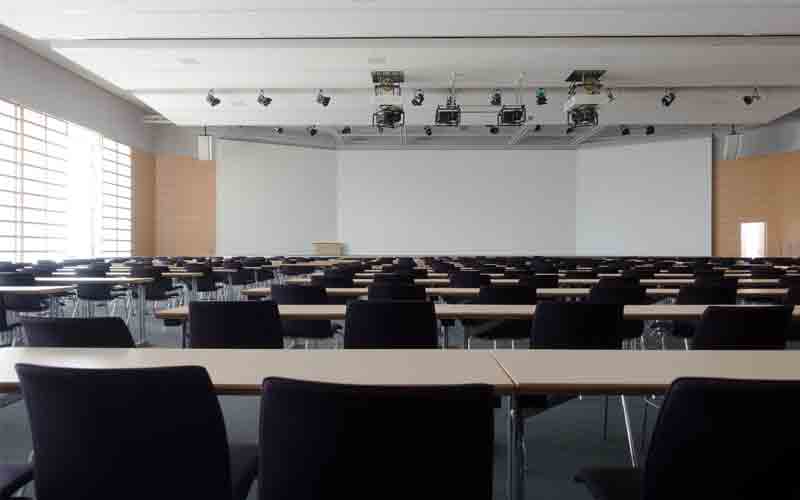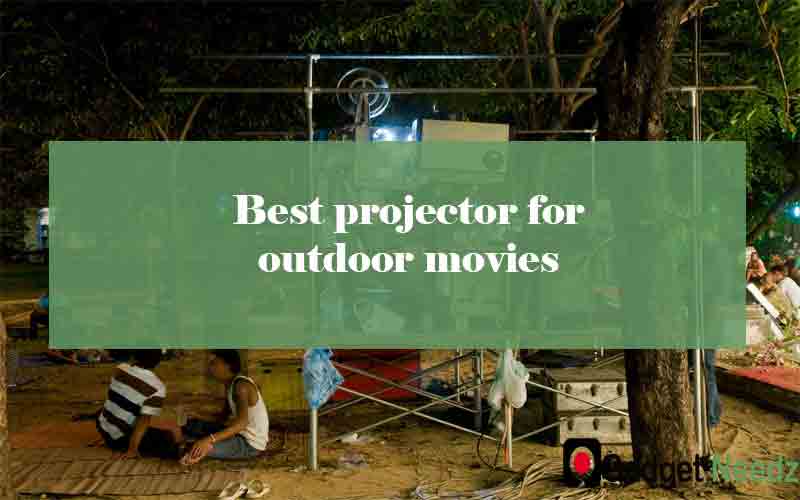Table of Contents
Well, around 2500 lumens are required to project on daylight, but the lumens might vary depending upon your usage.
Projecting movies or providing presentations in a dark room is one thing but projecting them in daylight is a whole different ball game.
You can’t expect to get a bright image output with standard lumens in bright daylight as the projector has to counter a lot of light intrusions. Now you must be wondering, how many lumens do you need to project in daylight?
Your projector needs to have the support of high lumens or lux of a projector to produce clear images under the sun.
However, hardly any user sets up their projector under direct sunlight as it is extremely tough, and you will need around 100,000 lumens to get a bright view.
Most of the users put their projector in a shady area of the outdoor so that they can get an excellent visual experience from their projector.
Previously projectors were not suitable in daylight, but nowadays, there are projectors that can tackle high ambient light to produce a bright image. Here in this article, we will discuss the daylight projector lumens you need under various circumstances.
But before we begin, let’s talk about the importance of lumens;
Significance Of Lumens In Daylight
Projecting an image in daylight is not easy, and there are many factors that influence the performance of a projector in daylight. Lumens are one of the vital factors that can make or break a bright image.
Depending upon the setup, the lumens amount will verify, but all the locations will require a high amount of lumen to counter ambient light.
Lumens or lux basically tells you the amount of brightness produced by a projector, and it is generally associated with the ANSI unit.
Lumens decides the capability of the projector to produce bright images and also clarity you will get in ambient light. A projector without proper lumens will only showcase muddy and faded visuals when you place it in a room filled with ambient light.
So you can understand, the brighter the lumens, the better will be the brightness, and the brighter will be projection output in the presence of ambient light, daylight, and various other light sources.
A bright projector not only counters the ambient light but also highlights the subtle textures that you would mostly see in a dark environment.
While providing a presentation on a large screen during the day, you would hardly get a clear view, but high lumens can help you get sharp texts and clear data images.
However, you can’t put the projector directly under sunlight as the projector would need more than 120,000 lumens to counter it.
Apart from providing the required brightness, lumens also play a vital role in popping out the colors without getting affected by high ambient light.
Even though contrast ratio is mainly responsible for clarity, lumens also play a vital role in ensuring a clear view by sustaining daylight. The requirement of lumens changes from application to application and also the location they are subjected to.
The range of 2500-3000 lumens is sufficient for interior locations during daylight where there is a lot of ambient light. In general, the brightness of a room tends to be decently lit during daylight.
However, you will need more than 3000 lumens to offset the high ambient light when you place the projector in outdoor locations in daylight.
It is vital that you select a bright projector when dealing with daylight, especially in outdoor locations where the sunlight can ruin the intensity of your projectors.
There are games that also need high brightness as the projector needs the support of lumens to highlight the dark areas of the visual. Similarly, presentation work on large screens also needs high lumens support as it has to fill up the white section of various image areas.
How Many Lumens Do You Need In Daylight?
We know it is confusing to decide the exact amount of lumens you need when projecting anything on daylight.
Unlike a typical situation where you can settle with low lumens, you will need thousands of lumens to offset the high light intensity coming due to daylight. However, the lumens count is entirely subject and varies from situation to situation.
The amount of lighting interfering with the projection will also serve as a determining factor for lumens selection. Here we will discuss the requirement of lumens based on various situations;
Interiors With Little Ambient Light
When you will use a projector in daylight inside your room, you won’t need a high amount of lumens. As you will use it in daylight, a decent amount of ambient light would interfere with your projection.
A lumens range between 1000 and 2000 would be required to project a crystal clear image on the screen. However, if you are planning to project on a large screen size with a high resolution like full HD or 4K, then it would be safe to go beyond 2000 lumens count.
In daylight, the projector would need every support from lumens to highlight all the pixels to create a high-resolution output.
However, it would be best to avoid super bright projector for indoor usage as they are expensive and tend to ruin the overall visual experience.
Bright Rooms With Huge Ambient Light
Projecting contents in bright rooms with a substantial ambient light due to daylight is quite tricky. You need to go beyond 2000 lumens, or else you will end up getting a faded and muddy view on the screen.
Rooms that face a lot of light leakage due to daylight would need at least 3000 lumens to create a sharp and colorful visual. Whether you watch movies or stream videos, you will need a complete package of high brightness to ensure a cinematic visual experience.
However, if you face the same situation in the office room (which is generally large) while providing a presentation, then you should go up to 4000 lumens to combat the outdoor light.
For some reason, if you have to keep the lights on, then it would get tricky for the viewer to get a clear look at the presentation screen.
In those situations, you would need around 5000-6000 lumens to ensure a crystal clear output despite the screen size. The same thing is applicable for classrooms where keeping the lights off is not always possible.
With lumens, you should also consider the other factors as it would be futile to get super high lumens with low contrast and poor color accuracy.
Backyard Entertainment
The scenario changes when you choose to go for backyard projection for watching movies or streaming TV series in the afternoon when the sun is at its peak.
The intensity of daylight in the outdoors in the morning and afternoon is very high, and you can’t simply work with a projector having low lumens around 1500.
Whether you want to watch videos on YouTube, use OTT platforms or play games, you have to settle with a projector offering more than 4000 lumens.
However, it would be best if you can get a projector that has lumens lying within the 5000-6000 lumens range. Not only will it be a safe choice, but it will also help the projector counter even the harshest ambient light from the sun.
Having a high lumens projector will allow you to go for a big screen in the backyard without worrying about the faded view.
With lumens more than 4000, you can easily play games with your friends and watch NFL at HD resolutions.
Presentation In Auditorium and Open Spaces
Providing a presentation in an auditorium or shaded area of a space can be tricky. You will have daylight attacking the projection screen from every side, and you can hardly do anything to control the light intrusion.
To project explicit texts and sharp data images, you need at least 5000 lumens, and the higher, the better. Along with high lumens, you will also need high resolution and a vast contrast ratio to support the lumens to showcase a crystal clear image.
However, if you have a lot of ambient light and you have to keep the lights on the auditorium, then it would be best to go for 6000 lumens or above.
Similarly, in large classrooms, you need to also go for the same amount of lumens, but it entirely depends upon the amount of ambient light in the room.
Effective Way To Get High-Quality Visuals In Daylight
Getting a high-quality visual in daylight is not an easy task as the image suffers a lot from the ambient coming due to the intense ray of the sun.
Not only do you get a faded and muddy output, but also the quality gets reduced by a certain margin. Using a high lumens projector is the most effective way to get a clear and sharp visual even when you are playing contents in the daylight.
Getting a high lumens projector within the range of 3000 lumens and 5000 lumens is practical and affordable. But when you go beyond the 5500 lumens range, especially over 6000 lumens, the projector gets really expensive, and most of them are limited to full HD resolution.
So it would be better if you can find a shaded area with minimal daylight intrusion and work with lumens around 4000-5000.
Along with high lumens, it would be best to use a high resolution because when you go for a big screen, you won’t see any kind of pixelation.
For presentation purposes, HD resolution is sufficient, but for movies and other entertainment, full HD and 4K would be an ideal choice.
Not having a proper projector screen during daylight will cause a lot of degradation in the visual experience and quality.
So if you use an ambient light rejecting screen, it can cut down the light reflection issue and get you a sharp image quality by offsetting the ambient light.
Basically, ALR screens are angled in such a way that they redirect the screen in different directions and allow the projector light to be entirely directed towards the audience.
Even if you have a high lumen and ALR, not arranging the setup in a shady area or places with minimal ambient light will ruin the whole experience. Practically it is not possible to get a clear view under direct sunlight, so you need to place the projector strategically.
Lastly, if you can control the ambient light around your setup area, then only you can have a great view without needing super high lumens.
Well, it is not possible to control daylight or light coming from the ceiling and bulbs. But it is possible to cover rooms with curtains, dim or switch off the lights, setting up a shade, or blocking peeping lights through ceilings.
Moreover, you should place the screen in such a way that it is directed away from sunlight, sun glare, and light reflection.
Conclusion
Through this article, we hope we have been able to answer how much lumens required to project on daylight based on different situations. Lumens are a critical aspect of any projector, especially when you will have to deal with daylight.
Working with high lumens helps you to negate the effect of daylight and produce a bright and detailed image even in the presence of daylight. However, along with a high daylight projector lumens, you also need to work on the setup and minimize the light intrusion as much as you can.
Related Articles:



